#L. Shankar
Explore tagged Tumblr posts
Text
youtube
Master musician Zakir Hussain has left this plane of existence, age 73.
Adept at Indian classical music and its hybridization with Western forms, he played with a wide range of Indian and Occidental musicians, including, as in the above and below, John McLaughlin in Shakti, the group they co-founded with L. Shankar and T. H. "Vikku" Vinayakram.
I had the pleasure of seeing him play in a small venue with L. Shankar yonks ago, and the dynamism of his playing and its interplay with the virtuosic Shankar were memorable.
Here he is with Shakti at Montreux in 1976. "Shredding" for the sake of it holds considerably less attraction for me than when I was a young sobsister, but these fuckers have chops for days and in time signatures that defy description.
aav.
youtube
#zakir hussain#l. shankar#john mclaughlin#t. n. “vikku” vinayakram#shakti#indian classical music#fusion music#obituary#live music#counting talas#Youtube
4 notes
·
View notes
Text
311: L. Shankar // Touch Me There

Touch Me There L. Shankar 1979, Zappa
My girlfriend fished this record out of the dollar bin because of its weird cover, noticed it was on Zappa Records, and figured I might find it interesting (good girlfriend). And… well, it is interesting. Perplexing might be the better word actually, as it’s hard to imagine who this record was supposed to be for. L. Shankar is an Indian violinist best known for playing in East-West fusion band Shakti with John McLaughlin (and later co-composing the Last Temptation of Christ score with Peter Gabriel, and later still doing a record with the guy from KoRn?); he ended up in Zappa’s late ‘70s band, and eventually cut this solo debut with the mustachioed one behind the boards. Touch Me There is an incoherent mix of the near-parodic beer commercial rock Zappa was churning out at the time, New Age-y violin instrumentals, and doofy fusion. The transition from snickering rocker “Dead Girls of London” (the single, with Frank contributing vocals) to spa muzak number “Windy Morning” at the top of the record is enough to give you whiplash, and it sets the tone for what’s to come, though side two eventually settles into a sleepy background music groove. Despite a stellar cast of session guys (a previous owner of my copy wrote “Simon Phillips!” in pen next to a song he drums on) it’s basically all trash. The sole highlight is “Knee Deep in Heaters,” a benzo’d ska number that splashes together Shankar’s peculiar falsetto and droning electric violin improvisations over a faux Caribbean beat that somewhat improbably works. (The aforementioned girlfriend’s actually here at the moment, and is kicking my ass at describing this song, so I’ll just throw it to her: “This is a very Major Lazer sample, y’know? It’s like the soundtrack to a scene where a guy’s been given some kind of drug and they’re like, ‘I don’t feel anything oh whoa.”) Anyway, this is a bad record, but as with most things Zappa, there’s at least much to scratch your head over.
youtube
311/365
#l. shankar#shankar#shakti#frank zappa#zappa#simon phillips#bad music#'70s music#jazz fusion#fusion#novelty rock#music review#vinyl record
3 notes
·
View notes
Text
youtube
Queen Of The Damned, directed by Michael Rymer
Lestat's violin, original score by Jonathan Davis, Richard Gibbs and L. Shankar
#queen of the damned#michael rymer#jonathan davis#richard gibbs#L. Shankar#lestat's violin#ost#soundtrack#score#Youtube
1 note
·
View note
Text
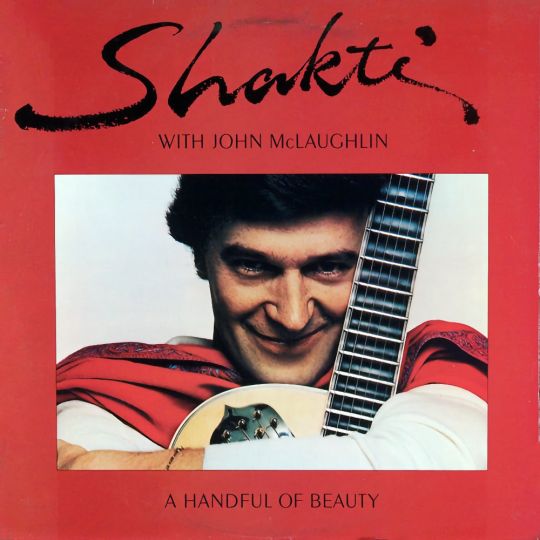
#shakti#lady l#a handful of beauty#john mclaughlin#zakir hussain#vikku vinayakram#lakshminarayana shankar
8 notes
·
View notes
Text
A Raga Renaissance Flowers in Brooklyn
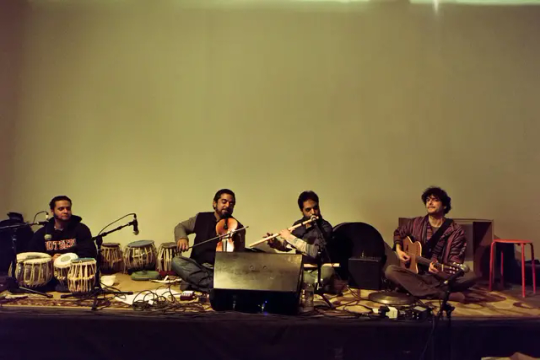
From left, Shiva Ghoshal, Arun Ramamurthy, Jay Gandhi and David Ellenbogen of Brooklyn Raga Massive jamming at Pioneer Works in Brooklyn.Credit...Loren Wohl for The New York Times
By Vivien Schweitzer March 24, 2016
The jeweled raiment and serene kohl-rimmed eyes of Saraswati, the Hindu goddess of knowledge, music and the arts, were projected on a screen behind the stage one recent evening at Pioneer Works, the exhibition and performance space in Red Hook, Brooklyn.
With an ensemble that blended Western instruments and traditional Indian ones, the tabla and sarod, two vocalists — Roopa Mahadevan, wearing a glittery silver sari, and Haleh Kilmer, in dark jeans and boots — sang selections including a tribute to the goddess rendered by Ms. Mahadevan in the haunting melismatic style of southern India. The evening celebrated Indian female cultural figures as well as the female members of the Brooklyn Raga Massive, a dynamic nonprofit collaborative formed in 2012 with a mission to expose new audiences to Indian classical music.
Such weekly events, held in spaces around the city, highlight different elements of the raga, the backbone of Indian music, and conclude with lively late-night jam sessions in which any musician who observes the house rules is welcome to participate. The Massive’s free-floating operations are a vital part of a flowering of Indian music in New York.
On April 6, the collective will offer a birthday tribute to Ravi Shankar, the influential sitar player who collaborated with Western musicians including the violinist Yehudi Menuhin and the flutist Jean-Pierre Rampal. Mr. Shankar’s impact led The New York Times in 1966 to declare that the raga was “becoming a rage in America,” although it deemed it a “curious fad.” The Massive refers to its current contemporary movement as a raga renaissance.
Yet according to Par Neiburger, the artistic director of the World Music Institute, the Massive is unusual in that, in contrast to the top-down traditionalist approach of most Indian musical organizations, with fierce loyalty to individual teachers and a strict guru-disciple hierarchy, its structure is free-form and democratic.
“There is a lot of improvisation in Indian classical music,” Mr. Neiburger said. “But the basic forms lend themselves to a tradition that is kept intact and hasn’t really been modernized in any extreme way.”

Anoushka Shankar, the sitar-playing daughter of the renowned sitarist Ravi Shankar, who plans an American tour in April to promote her new album.Credit...Simon Scheuller
Recent events presented by the Massive at Pioneer Works, where the collaborative is in residence until April 27, have included explorations of the Hindustani music of northern India; Indian film and dance; a collaboration with African musicians like the Malian singer Awa Sangho; and a tribute to George Harrison and the Beatles. Coming events include an exploration of Carnatic music, the idiom of southern India, on Tuesday, March 29, and, on April 13, a lineup mixing Cuban rhythms with raga melodies.
The Massive has also explored the influence of Indian music on prominent Western classical composers like Terry Riley, performing his “In C,” a Minimalist work from 1964, last year at the Rubin Museum; a recording on the Northern Spy Records label is due out later this year. In a concert in September at Le Poisson Rouge in Greenwich Village, it will celebrate the birthday of John Coltrane, who was fascinated by Indian music.
As the central element of Indian music, the raga originated with the ancient Vedic hymns sung in Hindu temples and is intended to create a trancelike spiritual mood. (The word, derived from Sanskrit, translates as “passion” or “color.”) It is composed from scales with ascending and descending patterns that form a melodic framework for improvisation and is associated with seasons, moods and events. Ragas open with an introspective prelude called the alap (performed without percussion) that evolves into a rhythmically invigorating section with percussion that often features virtuoso solo segments.
Ragas are largely monophonic, incorporating drones created by instruments like the tanpura, a long-necked plucked string instrument.
A spellbinding concert presented in February at the 92nd Street Y by the World Music Institute illuminated the Carnatic genre at its most sublime. The violinist L. Subramaniam (whose father, V. Lakshminarayana, expanded the role of the violin in the Carnatic tradition from background to solo instrument) joined his son, Ambi Subramaniam, also a violinist, for a mesmerizing performance.
Gentle wisps of melody shared by the two men slowly unfolded over a drone before morphing into a flurry of imaginatively ornamented, virtuosic riffs. When they were joined by two percussionists (Mahesh Krishnamurthy on the mridangam and Ravi Balasubramanian on the ghatam), the music reached ecstatic heights.
Anoushka Shankar, the daughter of Mr. Shankar and a sitar player who both performs classical Indian music and a fusion incorporating other influences, said in an interview that the traditional music in its pure form is struggling in India, where Bollywood and fusion music promoted by the Indian television series “Coke Studio @ MTV,” are popular. “It’s hard to compete in a short-sound-bite-driven market when a form of music is by nature about a slowly unfolding genre,” said Ms. Shankar, who plans an American tour in April timed to the release of her new album, “Land of Gold.”
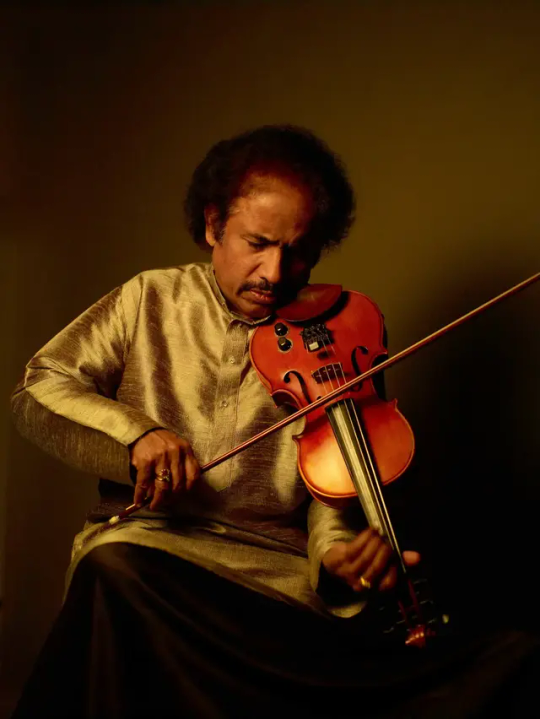
The violinist L. Subramaniam, who performed recently at the 92nd Street Y.
In the United States, Mr. Neiburger of the World Music Institute said, Indian classical music tends not to have “the broad appeal that some other world music genres might have, such as Brazilian music, fado and flamenco.” So the Massive teams up with others eager to attract new American listeners, like the Biryani Boys, a duo consisting of the tabla player David Freeman and the sitar player Mustafa Bhagat who also produce YouTube videos infused with hipster humor and featuring prominent Indian musicians.
On Saturday, April 2, at the Metropolitan Museum of Art, New Yorkers will have the chance to hear some of India’s most prominent musicians. Amjad Ali Khan will perform with his sons, Amaan and Ayaan Ali Khan, the seventh generation of a family of musicians who play the sarod, a long-necked lute prominent in classical northern Indian music.
Many of the Massive members perform Indian classical music in its pure form as well as experimenting with various fusions. An afternoon performance at the Met this month by the sitar player Neel Murgai and the tabla musician Sameer Gupta proved riveting, the soulful alap building in intensity to the colorful fast section called the jhalla.
In a contemporary music scene characterized above all by crossing and blurring genres, it’s possible to find all kinds of collaborations. Mr. Gupta and Mr. Murgai also perform with the violinists Arun Ramamurthy and Trina Basu, both trained in the Carnatic tradition, and the Western-trained cellist Marika Hughes as the Neel Murgai Ensemble. It performs what it describes as “raga chamber jazz,” a blend of Indian forms with everything from Tuvan throat singing to Roma tunes.
Ms. Basu also plays with the cellist Amali Premawardhana, the bassist Perry Wortman and the tabla player Roshni Samlal in the ensemble Karavika, which specializes in a soulful blend of classical and folk traditions from the United States and India.
The Massive members are proud of their open-minded outlook. “New forms are being created that are indigenous to Brooklyn,” Mr. Murgai said. As for the collective’s future goals, Mr. Gupta points out in a lighthearted Massive video that Pioneer Works is not far from the Statue of Liberty in New York Harbor.
“I have a dream,” he said, “that one day the statue won’t have a book and a torch but will have a sitar and a tabla.”
A version of this article appears in print on March 27, 2016, Section AR, Page 12 of the New York edition with the headline: A Raga Renaissance Flowers in Brooklyn.
#Amaan Ali Khan#Amali Premawardhana#Ambi Subramaniam#Amjad Ali Khan#Anoushka Shankar#Arun Ramamurth#Arun Ramamurthy#Awa Sangho#Ayaan Ali Khan#Biryani Boys#David Ellenbogen#David Freeman#George Harrison#Haleh Kilmer#Indian music#Jay Gandhi#Jean-Pierre Rampal#John Coltrane#Karavika#L. Subramaniam#Mahesh Krishnamurthy#Marika Hughes#Mustafa Bhagat#Neel Murgai#Par Neiburger#Perry Wortman#Ravi Balasubramanian#Ravi Shankar#Roopa Mahadevan#Roshni Samlal
0 notes
Text
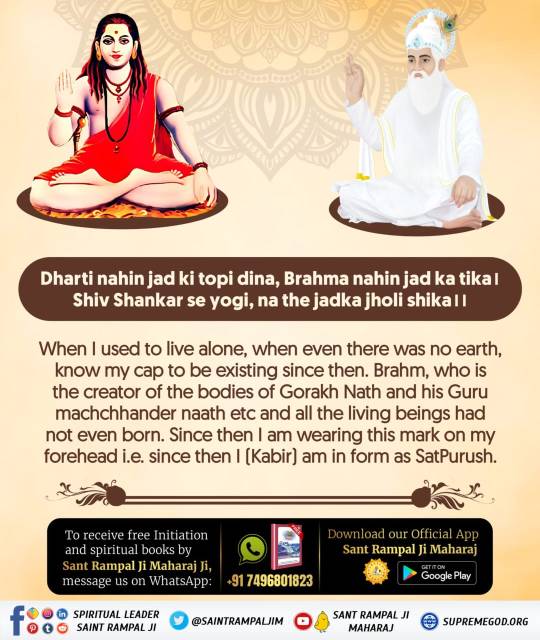
#Dharti nahin jad ki topi dina#Brahma nahin jad ka tika l Shiv Shankar se yogi#na the jadka jholi shika llWhen I used to live alone#when
0 notes
Note
https://www.esquire.com/entertainment/tv/a64929637/adi-shankar-castlevania-devil-may-cry-interview/
What a humble soul
Also I hope he's joking about Duke Nukem. Poor guy's suffered enough
At this point I don't even know why we're still following a guy who is clearly a 2000s style troll. He just says shit for the sake of stirring shit and he clearly has fun with it. Have you checked his Twitter header? lmao
Although based on a major video game franchise from Japanese titan Capcom, Devil May Cry is quite personal, reflective of how Shankar "saw the world" in 2001. "Season 1 is about how we all lost something as children, and we spend the rest of our lives trying to reclaim it or find it or heal from it," Shankar tells me.
You know, if I were more cynical, I would assume that this is just a way to shield himself from criticism against NDMC. "noooooo I didn't use a beloved IP about the heart of humanity to spread propaganda against Arabs! It was all my trauma!"
to be blunt, DMC fans didn't watch the show to see Shankar vent his issues, assuming this really was his intention. They wanted to watch a show based on DMC.
"There are shades of gray in my work because I don’t see the world as good versus evil," Adi Shankar tells Esquire. "There’s more nuance the more you get to know someone."
I see he's still on this. He really believes that moral greyness is "cruel genocidal villain who is sad". My dude, it's no longer revolutionary. Children cartoons have the same kind of villain.
Later he says:
Any good villain, any human being, is the hero of their story. There is logic and narrative justifying [them]. They don't go, "I'm going to do villainy." They're going, "I'm the hero."
Well... yeah. But a villain who thinks of themselves as in the right isn't automatically morally complex or grey. You are stroking yourself because you're not writing literal cartoon villains from the '80s.
The White Rabbit is pretty much NDMC's response to Dracula. He lost someone dear to him at the hands of few, and then decided the whole world would pay for that loss. His plan was way too large to be functional, and would have made things worse for literally everyone - Dracula would have lead every vampire to starvation, and the White Rabbit would have allowed the big warlord demons to invade the human world, doing to it what they did to the demon world. That's not being complex, that's being an asshole, and dumb too.
Besides, his works are full of utterly evil villains, or at least antagonists that barely get any redeeming qualities, who do things for the pleasure of having power or even hurting others. The Bishop who wanted to become the Church itself, Carmilla who wanted to take the world from Stupid Old Men, the Judge who killed children for shit and giggles, Death who just wanted to feed on souls (who is, accidentally, less morally grey than game Death, who is frequently described as Dracula's friend!). That Christian politician guy I already forgot the name of who has no other personality than "I AM AMERICAN AND I LOVE JESUS". Sparda himself was painted in a negative light for "trapping" the demons, like some weird demon Trump with his wall. Just say you have your own blorbos and go.
So much of your work deals with traumatic childhoods. You've mentioned before that you had a difficult upbringing.
I have absolutely no idea what the interviewer was talking about here, let alone Shankar's response.
What I'm trying to convey is that I am a generational fucking talent. I am the guy that can save Hollywood.
These are not just shows, but battle plans for an overdue American animation revolution.
I was a fan of so many things that disappeared and I was in a position of power to bring them back.
American animation doesn't have that. You have people stuck in Hanna-Barberaland. It's cool to me, but it's not cool to the NFL player pretending to be Goku. They're not going "Yabba Dabba-doo!" It's not fucking happening. That's my influence. I'm making American animation fucking cool. That's what I'm doing.
What's your vision for Duke Nukem? It's a middle finger to everybody.
I have goals. I want to body Arcane, surpass it in viewership... Arcane is the Joker lighting cash on fire, and it's great. With season 2 of Devil May Cry, I want to beat that. Show up to a tank fight with a water balloon and destroy the tank. Because that's cool.
I don't want to comment on these quotes because I think Shankar's dick is hard enough.
15 notes
·
View notes
Text

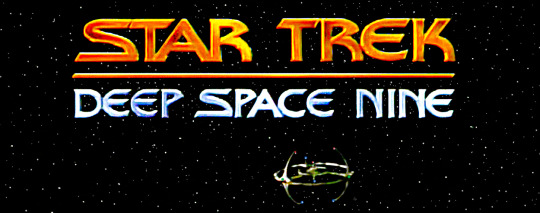

A C a l l t o A r m s
5th season episode 26 original airdate June 16, 1997
written by Ira Steven Behr and Robert Hewitt Wolfe directed by Alan Kroeker

I n t h e P a l e M o o n l i g h t
6th season episode 19 original airdate April 11, 1998
story by Peter Allan Fields teleplay by Michael Taylor directed by Victor Lobl

T r i a l s a n d T r i b b l e - a t i o n s
5th season episode 6 original airdate November 4, 1996
story by Ira Steven Behr Robert Hewitt Wolfe & Hans Biemler teleplay by Ronald D. Moore & Rene Echevarria directed by Jonathan West

D r . B a s h i r , I P r e s u m e ?
5th season episode 16 original airdate February 24, 1997
story by Jimmy Diggs teleplay by Ronald D. Moore directed by David Livingston

F a r B e y o n d t h e S t a r s
6th season episode 13 original airdate February7, 1998
story by Marc Scott Zicree teleplay by Ira Steven Behr & Hans Biemler directed by Avery Brooks

C h i l d r e n o f T i m e
5th season episode 22 original airdate May 3, 1997
story by Gary Holland Ethan H, Calk teleplay by Rene Echevarria

T h e S h i p
5th season episode 2 original airdate October 7, 1996
story by Pam Wigginton & Rick Cason teleplay by Hans Beimler directed by Kim Friedman

D u e t
1st season episode 19 original airdate June 13, 1993
story by Lisa Rich & Jeanne Carrigan-Fauci teleplay by Peter Allan Fields directed by James L. Conway

A T i m e t o S t a n d
6th season episode 1 original airdate September 27, 1997
written by Ita Steven Behr & Hans Beimler directed by Alan Kroeker

S a c r i f i c e o f A n g e l s
6th season episode 6 original airdate November 1, 1997
written by Ira Steven Behr & Hans Beimler directed by Alan Kroeker

T h e Q u i c k e n i n g
4th season episode 24 original airdate June 8, 1996
writter by Naren Shankar directed by Rene Auberjonois

T h e V i s i t o r
4th season episode 3 original airdate October 7, 1995
written by Michael Taylor directed by David Livingston

O u r M a n B a s h i r
4th season episode 10 original airdate November 25, 1995
story by Robert Gillan teleplay by Ronald D. Moore directed by Winrich Kolbe

V a l i a n t
6th season episode 22 original airdate May 3, 1998
written by Ronald D. Moore directed by Mike Vejar

I n P u r g a t o r y ' s S h a d o w
5th season episode 14 original airdate February 10, 1997
written by Robert Hewitt Wolfe and Ira Steven Behr directed by Gabrielle Beaumont

B y I n f e r n o ' s L i g h t
5th season episode 15 original airdate February 17, 1997
written by Ira Steven Behr and Robert Hewitt Wolfe directed by Les Landau

H o m e f r o n t
4th season episode 11 original airdate December 30, 1995
written by Ira Steven Behr and Robert Hewitt Wolfe directed by David Livingston

P a r a d i s e L o s t
4th season episode 12 original airdate January 6, 1996
story by Ronald D. Moore teleplay by Ira Steven Behr and Robert Hewitt Wolfe directed by Reza Badiyi

T h e M a g n i i c e n t F e r e n g i
6th season episode 10 original airdate December 27, 1997
written by Ira Steven Behr and Hans Beimler directed by Chip Chalmers

Y o u A r e C o r d i a l l y I n v i t e d
6th season episode 7 original airdate November 8, 1997
written by Ronald D. Moore directed by David Livingston

C h a n g e o f H e a r t
6th season episode 16 original airdate February 28, 1998
written by Ronald D. Moore directed by David Livingston

B a d d a - B i n g , B a d d a - B a n g
7th season episode 15 original airdate February 24, 1999
written by Ira Steven Behr and Hans Beimler directed by Mike Vejar

T o t h e D e a t h
4th season episode 23 original airdate May 11, 1996
written by Ira Steven Behr and Robert Hewitt Wolfe directed by LeVar Burton

I n q u i s i t i o n
6th season episode 18 original airdate April 4, 1998
written by Bradley Thompson David Weddle directed by Michael Dorn

T a k e M e O u t t o t o t h e H o l o s u i t e
7th season episode 4 original airdate October 21, 1998
written by Ronald D. Moore directed by Chip Chalmers

T h e S e i g e o f A R - 5 8 8
7th season episode 8 original airdate November 18, 1998
written by Ira Steven Behr & Hans Beimler directed by Winrich Kolbe

I t ' s O n l y a P a p e r M o o n
7th season episode 10 original airdate December 30, 1998
story by David Alan Mack & John J. Ordover teleplay by Ronald D. Moore directed by Anson Williams

L i t t l e G r e e n M e n
4th season episode 8 original airdate November 11, 1995
story by Toni Marberry & Jack Trevino teleplay by Ira Steven Behr & Robert Hewitt Wolfe directed by James L. Conway
7 notes
·
View notes
Text





The Girls of Hillcrest High (L-R): Raquel Torres, Taylor Metzenbaum, Mel Huang, Dionne Cunningham and Kamala Shankar
EDIT: Changed Shetty to Shakoor but it was too Muslim so I changed it to something Indian enough instead.
Made with: https://picrew.me/en/image_maker/587862
#dynasti's picrews#dynasti's ocs#the girls of hillcrest high#oc: raquel torres#oc: taylor metzenbaum#oc: mel huang#oc: dionne cunningham#oc: kamala shankar
12 notes
·
View notes
Text

Shakti - Ravinia Festival, Highland Park, Illinois, September 3, 2023
Tabla virtuoso Zakir Hussain passed away late last year — a huge loss. Hussain was, to say the least, a trailblazer, bringing the sounds of Indian classical music to a global audience and expanding that sound through a variety of adventurous collaborations. And Shakti, his band with guitarist John McLaughlin, violinist L. Shankar and R. Raghavan on mridangam, was one of the most adventurous of those collaborations, a true fusion of genres.
The final Shakti lineup featured vocalist Shankar Mahadevan, violinist Ganesh Rajagopalan and percussionist Selvaganesh Vinayakram joining Hussain and McLaughlin for a well-deserved victory lap — and longtime friend of the blog Joel has kindly shared his tape of the group playing a magnificent late-summer show from a few years back. The pure athleticism of Hussain's playing remains; hard to believe he was in his 70s. But the slower moments are just as amazing, deeply soulful, immensely joyous.
streaming | mp3 | wav | flac
Zakir Says: The excitement is learning. My father once told me, “Don’t try to be a master: Just be a good student.” Every time I play with a musician I’ve never played with before, I learn something new. When I play with Bela Fleck, John McLaughlin or Mickey Hart, I learn from them. That allows me to expand my repertoire into territories it’s never gone before. The tabla is a unique instrument in the sense that it has the capacity to absorb whatever information to print on it. It will bend to the needs of the moment.
6 notes
·
View notes
Text
The Red Devil's Chronicles - Devil May Cry March & April 2025 News Updates: Interviews, Netflix, PGR, etc.
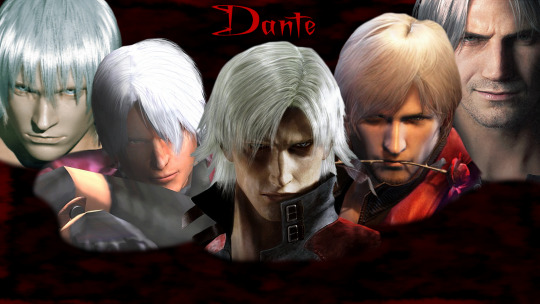
Hey there, how’s it going? Here are the latest Devil May Cry news updates I’ve gathered:
1. Hideaki Itsuno and Hideki Kamiya had a panel together, talking about their job roles in gaming.
2. New Dante acrylic stand from Capcom.
3. DMC4 Producer Hiroyuki Kobayashi admits to what gaming companies’ goals are nowadays.
4. Reuben Langdon talks Devil May Cry once again in an interview. b) Speaking of Reuben, he’s still waiting for that call to be back in Devil May Cry. c) Turns out he finally got that role for that PGR X DMC mobile game, along with Dan Southworth returning as Vergil.
5. Johnny Bosch also talks Devil May Cry in a new interview.
6. Presslee’s fan game’s planned on being released soon.
7. Now for all the Netflix-related updates: a) I feature in 2 parody vids by RealNeroRedgrave where in this 1st one, I’m the Barbie-looking gal with the baby. b) And Lady in this other one. c) V-Tuber Netflix Dante. d) V-Tuber Dante attempting to sing Evanescence’s Afterlife song. e) Evanescence’s Amy Lee gets her own dakimakura pillow of Netflix Dante. f) Merch available. g) Adi Shankar dresses up as Dante while attending a wrestling event. h) And meet a couple wrestlers. i) Behind the scenes of one of the animators. j) Behind the scenes of how Dante’s DDR dance was made. k) Concept arts of Dante. l) Lady m) White Rabbit n) Misc 1 o) Misc 2 p) Tynah on Twitter/X made a custom Netflix Dante figure. q) Season 2 has already been announced. r) Evanescence’s Afterlife music video shows a sneak peek at Season 2. s) Casey Edwards confirms he’s making music for Season 2.
My Thoughts On These Updates:
1. It’s nice to see the 2 Devil May Cry directors coming together to talk about their roles and goals. Would be awesome if they can collab but knowing them both and from what they’ve stated there, it’s best if they direct separately.
2. Nice that Capcom’s still coming out with Devil May Cry merch.
3. It’s too bad what the gaming industry’s become nowadays...There are still great games being made out there, but the marketing and developing aspect of it’s really gone downhill. At the same time, that title for that article there was kinda click-baity ‘cause it talked more about Japan’s stance on localization changes more than what the title and what I stated earlier.
4. That was a very nice interview, and is awesome that Reuben finally got a Dante role again, along with Dan Southworth as Vergil. So that thing Dan was talking about last year at that Power Rangers panel was either about the PGR game, or his role in Ninja Gaiden 4. Kinda funny how Reuben mixed up DMCV for DMC6 there in the interview as well, heheh.
Aside from that, though...I apologize that I’m bringing something bad up here, but I need to let this out...It’s regarding the questionable activities Reuben’s been displaying on social media as of late…I know the guy’s had controversies before, but I feel like most of these controversies have been misunderstandings due to the character limitations on Twitter/X that can make one explain things poorly, and how people’s mindsets and emotions get messed up when it comes to political stuff. Just what he’s been displaying lately has me concerned and taken aback, though...I would give my full opinion about the matter, but I don’t want to overstate things here. So if you have any questions about this, you can either leave a comment or DM.
5. Also a nice interview with Johnny Bosch there. Looking forward to his future Devil May Cry stuff (and Trigun)
6. Was wondering what was going on with PressLee’s project there...Curious on how it’s gonna turn out.
7. Hoo-boy…Where to start when it comes to the Netflix stuff? Well, I’ve given my review already on here about my thoughts on it. Despite me liking it, it definitely had some rough edges that needs smoothing out.
- It was an honour being part of a couple parody vids. It’s not very often that I do voice stuff anymore due to lack of privacy and such. One of my dream jobs is to get into voice acting, but is tough when you lack privacy and live out in an area too far away from an actual recording studio.
- V-Tuber Dante’s a neat idea, but...IMO kinda weird and cringe too...Sorry…
- Some of the topics given about what’s stated here in these news updates I don’t really wanna give my feedback on ‘cause I can’t come up with things to say about them other then “funny”, or “nice”, or “cool”...I apologize...
- It’s interesting how we’re already getting Season 2 stuff announced and such. Seems like we’ll be getting it quicker than expected, and kinda explains why it took so long for them to release this series. Hoping for the best out of this next season.
5 notes
·
View notes
Text
Through local papers and word of mouth, volunteer Daya Shankar keeps track of a very specific cause of death. As soon as he receives news of someone being struck by lightning around his neighborhood in Jharkhand, East India, he picks up his motorcycle and heads to the destination. Sometimes he travels alone, other times with a team of five or six from the organization he volunteers for, the Lightning Resilient India Campaign. It’s a task he is undertaking increasingly often.
Last month, he rode to meet the Manjhi family, who lost an 8-year-old boy, Viresh, and his mother, Subodhra, after a tea stall they were sheltering under was struck during a storm. A lightning bolt can generate temperatures three times hotter than the surface of the sun, with a voltage millions of times higher than a household socket. If it connects with a human, it can stop the heart and respiratory system, damage the brain and nervous system, leave major burns, and cause blunt trauma if victims are flung by the force of being struck. On the day the Manjhis died, lightning also killed another person in the village and injured five others.
Each year, an estimated 24,000 people worldwide are killed by lightning. While a significant number, deaths per head of population have fallen sharply over the past two centuries, thanks largely due to urbanization, the protection of more substantial housing, and improved weather forecasting. But India’s large rural population remains badly affected. Between 2,000 and 3,000 Indians die annually by lightning, most of them working class people aged 10 to 50. Fatalities have risen by more than 50 percent since the turn of the century, outstripping population growth. Compare that to the US, where fatalities have been gradually falling and number around 20 a year. India can experience more than that number of deaths in a day.
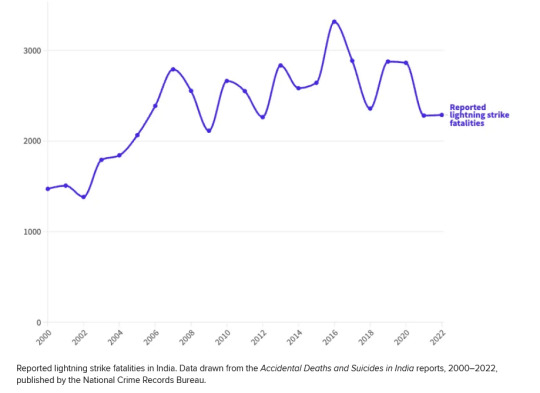
For every person who is killed by lightning, roughly another nine are struck and survive, often with life-changing injuries. And with climate change making stormy weather and lightning more common, activists like Daya believe the Indian government is failing to protect its people. “A bare minimum would be to at least spread information about all things lightning at local government level,” says Daya.
India has systems in place to predict dangerous storms. These work by gathering a lot of precise data, says Sanjay Srivastava, chair of the Climate Resilient Observing-Systems Promotion Council (CROPC), an intergovernmental institute that works to develop resilience against climate change impacts. Srivastava is also the convener of the Lightning Resilient India Campaign.
“Detecting the precise location of a lightning cloud-to-ground strike is a calculation mechanism where a minimum of three devices are required,” says Srivastava. These are radio frequency detectors, to detect the radio waves produced by lightning; a doppler weather radar, to detect precipitation and wind patterns associated with storms that may produce lightning; and a lightning detector, a device specifically designed to detect the electromagnetic signals produced by lightning strikes.
As of April 2022, India’s National Remote Sensing Center had 46 lightning-detection sensors installed across the country. Another institute, Indian Institute of Tropical Meteorology, Pune, has 83 in place. These, along with other private and institutional data, monitor and guide India’s lightning strike warning system.
The data shows that Jharkhand and other neighboring regions in East and Central India are among the country’s hot spots, as they are where hot and dry air currents from the northwest meet moist easterly currents. When clouds encounter warmer air, moist air rises until it reaches the subzero temperatures of the upper atmosphere, where it can freeze into ice particles called graupel. As these then collide with other ice particles, they generate electrostatic charges, which can eventually lead to lightning. Rising global temperatures are increasing this phenomenon.
However, despite advancements in meteorology, the full mechanisms behind lightning’s formation and behavior remain partially shrouded in mystery. The precise triggers, the exact nature of how lightning propagates through the atmosphere, and the factors that determine the intensity of each strike are still not fully understood. The risk to human life can be predicted in only fairly broad terms.
And while these early warning systems exist, their information often does not reach people in time. This is why volunteers like Shankar work to inform people on how to stay safe and teach how to build easy-to-make lightning arrestors—devices that neutralize cloud-to-ground lightning.
The day Shankar visited the Manjhis’ house, it was drizzling. On the way he spotted farmers and locals sheltering under trees. He stopped to inform them that standing under a tree during rainfall increases the chances of getting hit by lightning. But they said there was no other place where they could take shelter.
Lightning strike casualties are more prevalent in rural areas where infrastructure is limited. Concrete houses, which can have protective Faraday cage effects, are less prominent there than in cities, while tall vegetation, which workers might shelter under, can attract strikes. Densely populated areas in stormy regions also see more casualties. “We can say there are two factors behind lightning casualties. There are lots of environmental factors, and then there are socioeconomic factors,” says Anand Shankar, who works at the India Meteorological Department at the Ministry of Earth Sciences in the state of Bihar (Anand and Daya are not related).
Increasingly, attention is focusing on air quality too. In recent research for Bihar, which neighbors Jharkhand and is one of the worst affected states in India, Anand found that particulate matter in the air increased lightning activity in the region. Aerosols such as pollution or dust particles can affect the friction between the particles that generate lightning and make it more common.
But to what extent growing casualties in Bihar can definitively be attributed to pollution or global warming isn’t yet clear, says Ashish Kumar, a colleague of Anand’s at the IMD. “We had no data before 2015–16, so we have not come to the conclusion whether this is happening recently due to climate change.” But Kumar doesn’t refrain from pointing out that a warming planet can lead to increased lightning activities. Research has projected that a 1 degree Celsius rise in temperature can lead to a 12 percent increase in lightning strikes.
When Daya reached the Manjhis’ house, the family told him that Viresh and Subodhra had taken shelter under a plastic-roofed tea stall because a storm had hit on their way back home from their farm. “People consider that saving themselves from the water is most important,” he says, but they fall prey to dangerous lightning strikes if they stand under something that can act as a conductor. “The best option for them would have been to find a concrete shelter.”
Spreading this sort of knowledge is why volunteers like Daya hunt for the places where recent lightning deaths have taken place. “We often arrange talk shows and plays and other things in the rural areas, but people are either too busy or not interested. But when such accidents take place, people get aware and are willing to listen,” he says.
Another way the Lightning Resilient India Campaign tries to reach the masses is through schoolchildren. “They are curious and spread the message in their families and communities,” Daya says. Warnings are also pushed through government hooters and through mobile applications like the Damini app, which triggers a warning notification before a lightning strike.
“It is not like a cyclone, where you have seven days and you are evacuating people,” says Srivastava. “It’s instant. So, those 30 minutes or three hours are the golden hours.” But often farmers who live far away from their houses do not bring mobile phones to their fields and leave very early for work, and might miss the warning alert.
Srivastava and Anand agree that the best solution would be to put up more lightning arrestors. But with limited funds and a lack of government support, campaign volunteers have to resort to promoting the use of DIY lightning arrestors in high-risk areas. These can be made by fixing the metal rim of a bicycle wheel high up on a bamboo stick and attaching the rim to the ground using copper wire. “They are not bad for a small area, but their efficiency is limited when compared with bigger lightning arrestors,” says Srivastava.
In the absence of adequate protections, 16 of the 36 states and union territories in India have started accepting lightning strikes as a state disaster, including Bihar and Jharkhand, and so pay out compensation money of 400,000 rupees ($4,766) to the family of a deceased person. This does something to help families handle the economic shock of losing someone, but still leaves thousands unsupported. “Only 10 percent of people die—90 percent are left with a social trauma,” says Srivastava. “We need to create a psychosocial relief and also proper medical treatment for those who survive,” he says.
6 notes
·
View notes
Text
Interesting Papers for Week 7, 2024
Targeted memory reactivation in human REM sleep elicits detectable reactivation. Abdellahi, M. E., Koopman, A. C., Treder, M. S., & Lewis, P. A. (2023). eLife, 12, e84324.
Dynamics of cortical contrast adaptation predict perception of signals in noise. Angeloni, C. F., Młynarski, W., Piasini, E., Williams, A. M., Wood, K. C., Garami, L., … Geffen, M. N. (2023). Nature Communications, 14, 4817.
Continuous odor profile monitoring to study olfactory navigation in small animals. Chen, K. S., Wu, R., Gershow, M. H., & Leifer, A. M. (2023). eLife, 12, e85910.
Object representation in a gravitational reference frame. Emonds, A. M., Srinath, R., Nielsen, K. J., & Connor, C. E. (2023). eLife, 12, e81701.
Metacognitive judgments during visuomotor learning reflect the integration of error history. Hewitson, C. L., Al-Fawakhiri, N., Forrence, A. D., & McDougle, S. D. (2023). Journal of Neurophysiology, 130(2), 264–277.
Temporal scaling of dopamine neuron firing and dopamine release by distinct ion channels shape behavior. Juarez, B., Kong, M.-S., Jo, Y. S., Elum, J. E., Yee, J. X., Ng-Evans, S., … Zweifel, L. S. (2023). Science Advances, 9(32).
Evidence for a common mechanism supporting invigoration of action selection and action execution. Kita, K., Du, Y., & Haith, A. M. (2023). Journal of Neurophysiology, 130(2), 238–246.
Causal evidence for the processing of bodily self in the anterior precuneus. Lyu, D., Stieger, J. R., Xin, C., Ma, E., Lusk, Z., Aparicio, M. K., … Parvizi, J. (2023). Neuron, 111(16), 2502-2512.e4.
Long- and short-term history effects in a spiking network model of statistical learning. Maes, A., Barahona, M., & Clopath, C. (2023). Scientific Reports, 13, 12939.
State-dependent coupling of hippocampal oscillations. Modi, B., Guardamagna, M., Stella, F., Griguoli, M., Cherubini, E., & Battaglia, F. P. (2023). eLife, 12, e80263.
Expectations about precision bias metacognition and awareness. Olawole-Scott, H., & Yon, D. (2023). Journal of Experimental Psychology: General, 152(8), 2177–2189.
Not what u expect: Effects of prediction errors on item memory. Ortiz-Tudela, J., Nolden, S., Pupillo, F., Ehrlich, I., Schommartz, I., Turan, G., & Shing, Y. L. (2023). Journal of Experimental Psychology: General, 152(8), 2160–2176.
Altered oculomotor flexibility is linked to high autistic traits. Pomè, A., Tyralla, S., & Zimmermann, E. (2023). Scientific Reports, 13, 13032.
Dissociation of vicarious and experienced rewards by coupling frequency within the same neural pathway. Putnam, P. T., Chu, C.-C. J., Fagan, N. A., Dal Monte, O., & Chang, S. W. C. (2023). Neuron, 111(16), 2513-2522.e4.
Ventrolateral prefrontal neurons of the monkey encode instructions in the ‘pragmatic’ format of the associated behavioral outcomes. Rozzi, S., Gravante, A., Basile, C., Cappellaro, G., Gerbella, M., & Fogassi, L. (2023). Progress in Neurobiology, 229, 102499.
Testing the generalization of neural representations. Sandhaeger, F., & Siegel, M. (2023). NeuroImage, 278, 120258.
A neural mechanism for terminating decisions. Stine, G. M., Trautmann, E. M., Jeurissen, D., & Shadlen, M. N. (2023). Neuron, 111(16), 2601-2613.e5.
Subtle adversarial image manipulations influence both human and machine perception. Veerabadran, V., Goldman, J., Shankar, S., Cheung, B., Papernot, N., Kurakin, A., … Elsayed, G. F. (2023). Nature Communications, 14, 4933.
Distinct roles of the orbitofrontal cortex, ventral striatum, and dopamine neurons in counterfactual thinking of decision outcomes. Yun, M., Nejime, M., Kawai, T., Kunimatsu, J., Yamada, H., Kim, H. R., & Matsumoto, M. (2023). Science Advances, 9(32).
Alternating capture of attention by multiple visual working memory representations. Zhang, L., & Yamada, Y. (2023). Scientific Reports, 13, 13029.
#neuroscience#science#research#brain science#scientific publications#cognitive science#neurobiology#cognition#psychophysics#neurons#neural computation#neural networks#computational neuroscience
13 notes
·
View notes
Text
I have very vague memories of that Queen of the Damned movie but I do remember the only good things about it were Aaliyah and the violin music played on the beach which I just looked up and apparently was composed by famous violinist L. Shankar.
So yeah next season of iwtv will surely have lots of violin playing and I don't know much about violin music but I know the Devil's Trill Sonata - too on the nose or exactly Lestat's hiding-in-plain-sight style? I don't think the second book specifies which piece he plays that awakens Akasha but if the show goes there it'll have to be something pretty special that could plausibly (not like actually plausibly but you know what I mean) reanimate a 6000 year old comatose, ossified statue queen.
3 notes
·
View notes
Text
youtube
Tony Levin - Bringing It Down to the Bass - Single Edit - a sample of his forthcoming solo album, sounding like a jazzier King Crimson (imagine!) (video reeks of AI though)
The first single and title track "Bringing It Down to the Bass" features Manu Katché (drums), Dominic Miller (guitar), Pete Levin (keyboards), and Alex Foster (sax). Tony Levin's new solo album Bringing It Down to the Bass will be available September 13th from Flatiron Recordings. Special guest on the album include Robert Fripp, Mike Portnoy, David Torn, Jerry Marotta, Larry Fast, Steve Gadd, Steve Hunter, Pat Mastelotto, L. Shankar, Gary Husband, Jeremy Stacey, Colin Gatwood, Markus Reuter and Vinnie Colaiuta.
2 notes
·
View notes
Text
THE 150 GREATEST (FORMAL & INFORMAL) PERSONALITIES IN THE KNOWN HISTORY/COLLECTIVE CONSCIOUSNESS OF INDIA !
(THE FREE-FOR-ALL LIST, NOT RESTRICTED TO PADMA AWARDEES OR STAMP HOLDERS, EVEN IF INCL A MAJORITY OF THEM )
Ie. THE 150 GREATEST PEOPLE IN INDIAN HISTORY !
Rajesh Khanna
C.V. Raman
Online Indie
Jayaprakash Narayan
J.R.D. Tata
Subhash Chandra Bose
Swami Vivekananda
Lal Bahadur Shastri
Srinivasa Ramanujam
Bhagwan Sri Sathya Sai Baba
Valmiki
Bhagwan Shri Shirdi Sai Baba
Ramakrishna Paramhansa
Bhagwan Shiva
Bhagwan Ganesha
Mata Parvati / Amma Karunamayi
Bhagwan Krishna
Bhagwan Ram
Bhagwan Mahavira
Maharana Pratap
Jagadish Chandra Bose
Major Dhyan Chand
Govind Ballabh Pant
Lala Lajpat Rai
Dhirubhai Ambani
Meena Kumari
Mother Teresa
Chhatrapati Shivaji
Bal Gangadhar Kher
Madan Mohan Malviya
Kishore Kumar
Dr. Sarvapalli Radhakrishnan
Dr. Bhagwan Das
Guru Nanak
Allama Mashriqi
Lokmanya Tilak
Tansen
Lord Hanuman
Vithalbhai Patel
Atal Behari Vajpayee
P.U.M. Thevar
Nandlal Bose
Rabindranath Tagore
Dr. Babasaheb Ambedkar
Prem Chand
Jesus Christ
Adi Shankaracharya
K. L. Saigal
N. T. Ramarao
Dr. Devi Prasad Shetty
B. R. Chopra
Viswanathan Anand
Sri Aurobindo
Rani Laxmibai
Chakravarti Rajagopalachari
Narendra Modi
Milkha Singh
Mirza Ghalib
Dr. K.S. Krishnan
Dr. Satyendra Nath Bose
Dr. Zakir Hussain
Dr. M. Visvesvaraiya
Satyajit Ray
Bankim Chandra Chatterjee
Ramana Maharishi
Radha (Ancient Krishna devotee)
Chandulal Madhavlal Trivedi
Mahatma Jyotirao Phule
Savitribai Phule
Lt. Col. Maharaj Kumar Namgyal
Shammi Kapoor
Indira Gandhi
Dev Anand
Jijabai
Sadhu Vaswani
Raja Ravi Varma
Saiyid Fazl Ali
Ashok Kumar
Dr. Madhav Shrihari Aney
Gopal Das Neeraj
Ajudhia Nath Khosla
Shashi Kapoor
Ustad Bade Ghulam Ali Khan
Dr. Arcot Lakshmanaswami Mudaliar
Bipin Chandra Pal
Dr. Jnan Chandra Ghosh
Paramhansa Yogananda
Thiruvallavur
Buddha
Maharishi Patanjali
Dr. Nambi Narayanan
Dr. Verghese Kurien
Dadasaheb Phalke
Arjun (of Gita)
Waheeda Rehman
Dr. P.V. Kane
Jigme Dorji Wangchuk
Veer Savarkar
Thakkar Bapa
Ahilyabai Holkar
Rash Behari Bose
Sane Guruji
Maharishi Mahesh Yogi
Swami Ranganathananda
Dr. Shanti Swarup Bhatnagar
M. S. Subbalakshmi
Dr. Satish Dhawan
Chaitanya Mahaprabhu
Surdas
A. Ramaswamy Mudaliar
Mohandas Karamchand Gandhi
Prafulla Chandra Roy
Kabir (pre-independence poet)
Zubin Mehta
Kalidasa
Suchitra Sen
Tyagaraja
M. G. Ramachandran
Dr. Prabha Atre (classical singer)
Kavi Pradeep
Pt. Kishan Maharaj (tabla)
R.K. Laxman
Mirabai
Tulsidas
Uttam Kumar
Dr. K. Kasturirangan
Ashfaqullah Khan
Dr. Dhondo Keshav Karve
Ram Prasad Bismil
Chandrashekhar Azad
Tenzing Norgay
N.R. Narayana Murthy
Kumaran Asan
Bhai Vir Singh
Dr. Shyama Prasad Mukherjee
Dr. John Matthai
Subramanya Bharati
Pt. Omkarnath Thakur
Emperor Indravarman (of Srivijaya Empire (7th c – 12th c))
Vaidyaraj Sushil Kumar Jain (Jaipur, present day)
Sant Tukaram
Emperor Lalitaditya Muktapida (of Karakota Empire(7th c–9thc))
Peshwa Balaji Vishwanath (Maratha Empire)
Emperor Akbar (Mughal Empire)
Laxmikant-Pyarelal
R.D. Burman
Shankar-Jaikishan
S. D. Burman
Manoj Kumar
Mohammad Rafi .




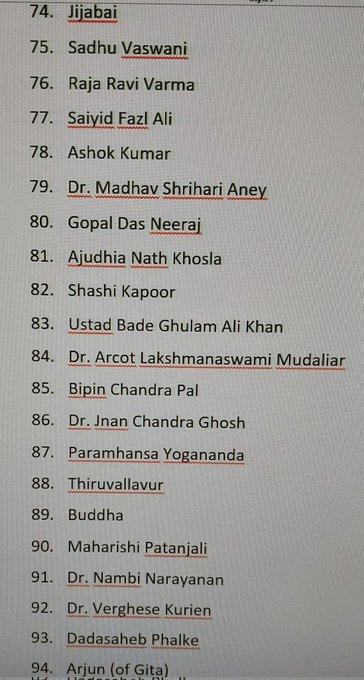
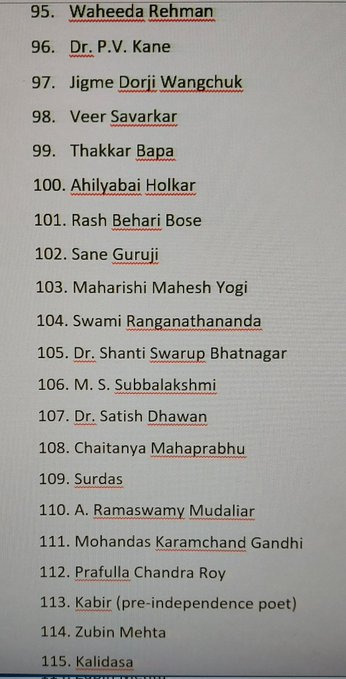



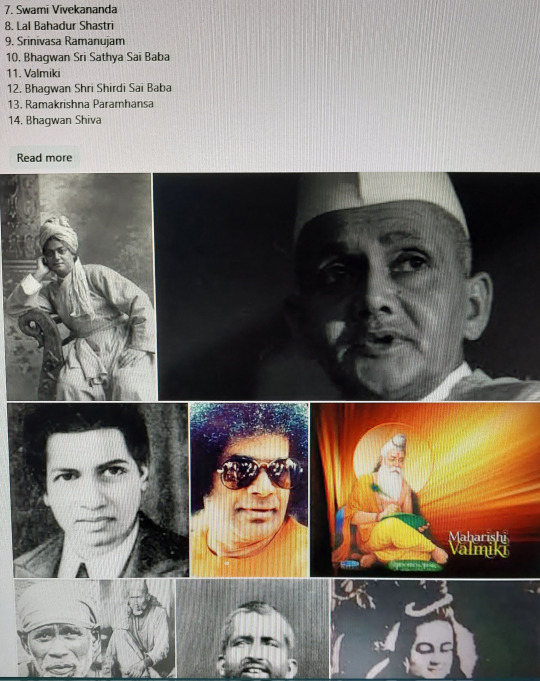
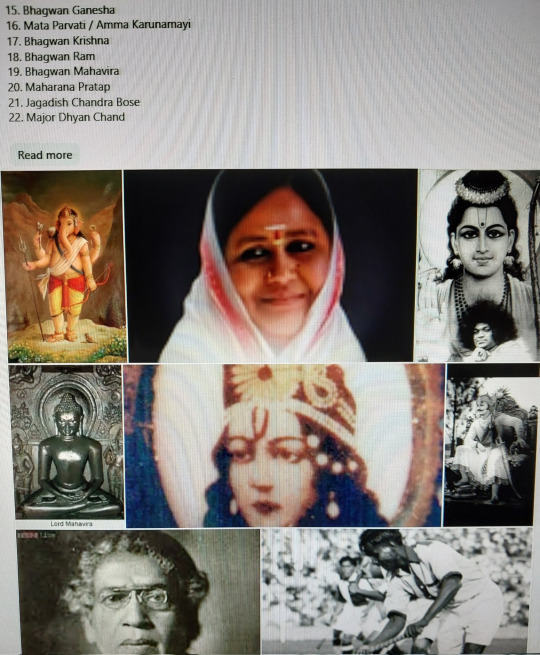



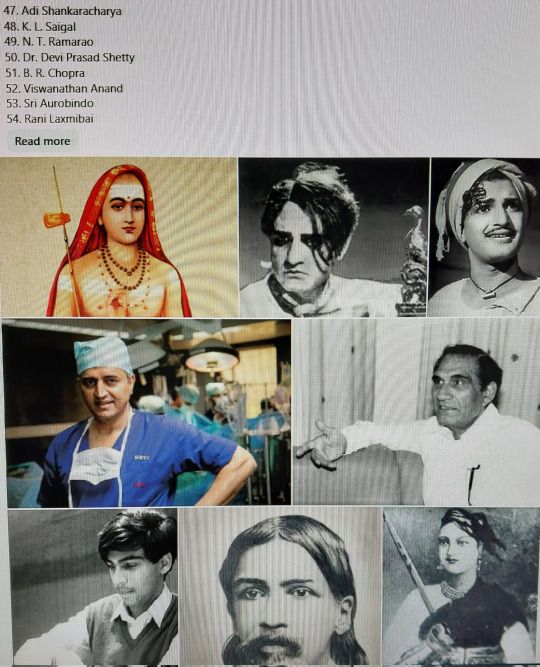




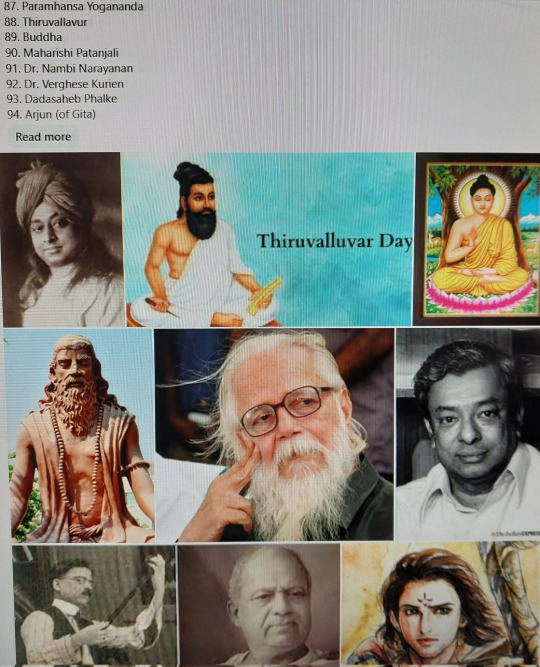
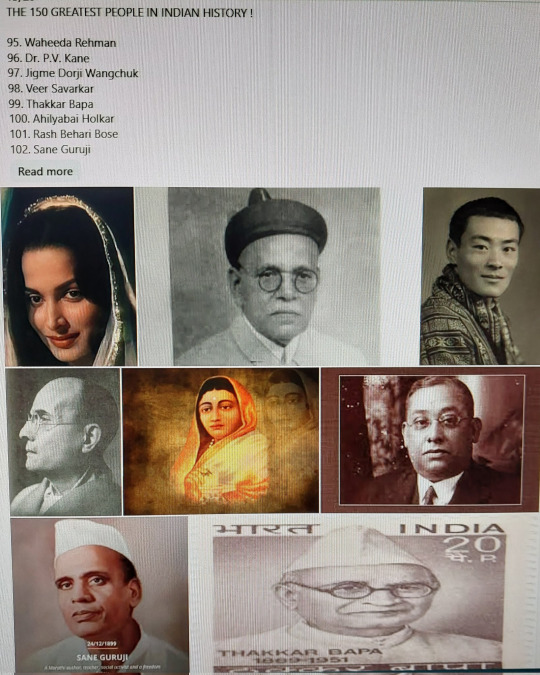


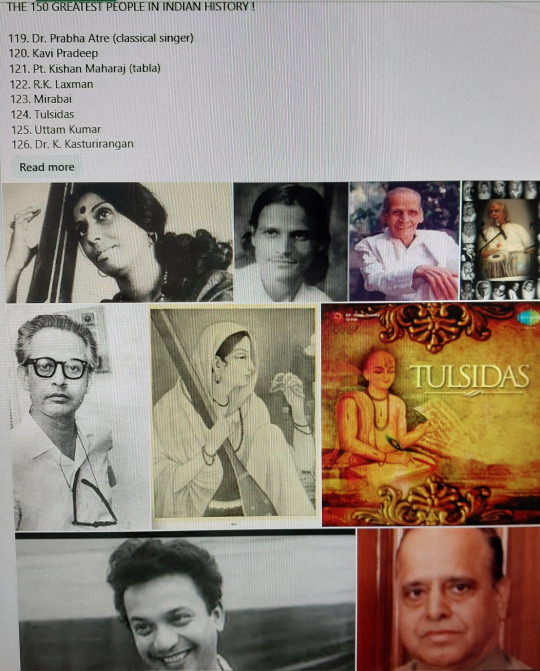
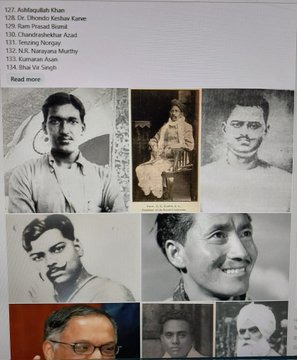
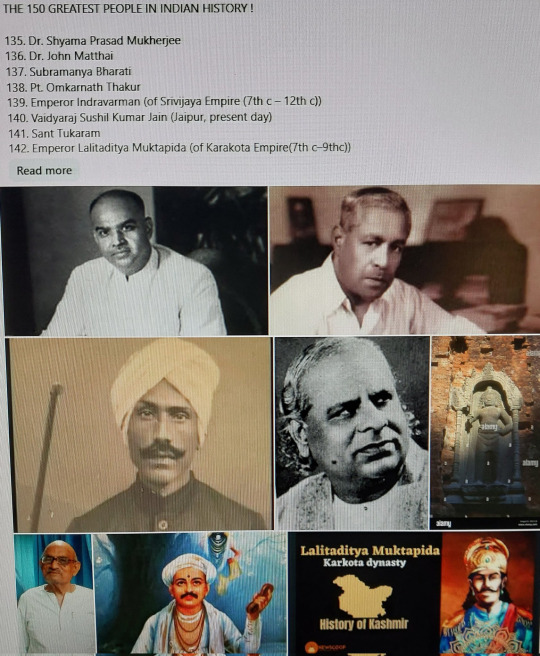

2 notes
·
View notes